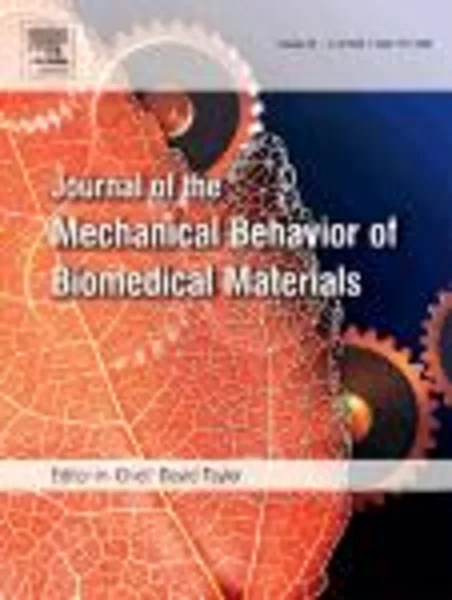-
time-dependent evaluation of mechanical properties and in vitro cytocompatibility of experimental composite-based nerve guidance conduits
جزئیات بیشتر مقاله- تاریخ ارائه: 1394/01/01
- تاریخ انتشار در تی پی بین: 1394/01/01
- تعداد بازدید: 650
- تعداد پرسش و پاسخ ها: 0
- شماره تماس دبیرخانه رویداد: -
the use of nerve guidance conduits to repair peripheral nerve discontinuities has attracted much attention from the biomaterials community, with many resorbable and non-resorbable materials in clinical use. however, a material with ideal biocompatibility, sufficient mechanical properties (to match that of the regenerating nerve) coupled with a suitable degradation rate, has yet to be realized. recently, potential solutions (composite nerve guidance conduits) which support the emerging philosophy of allowing synthetic materials to establish key interactions with cells in ways that encourage self-repair (i.e. ionic mediators of repair such as those observed in hard tissue regeneration) have been proposed in the literature; such composites comprise specially designed bioactive phosphate-free glasses embedded in degradable polymeric matrices. whilst much research has focussed on the optimization of such composites, there is no published literature on the performance of these experimental compositions under simulated physiological conditions. to address this key limitation, this paper explores the time-dependent variations in wet-state mechanical properties (tensile modulus and ultimate tensile strength) for ngc composites containing various compositions of plga (at 12.5, and 20 wt%), f127 (at 0, 2.5 and 5 wt%) and various loadings of si–na–ca–zn–ce glass (at 0 and 20 wt%). it was observed that young’s modulus and ultimate tensile strength of these composites were in the range 5–203 mpa and 1–7 mpa respectively, indicating comparable mechanical performance to clinical materials. furthermore, an analysis of the cytocompatibility of experimental compositions showed comparable (in some instances superior), compatibility when compared with the commercial product neurolac®. based on current synthetic devices and the demands of the indication, the cngcs examined in this work offer appropriate mechanical properties and compatibility to warrant enhanced development.
مقالات جدیدترین رویدادها
-
استفاده از تحلیل اهمیت-عملکرد در ارائه الگوی مدیریت خلاقیت سازمانی و ارائه راهکار جهت بهبود
-
بررسی تاثیر ارزش وجوه نقد مازاد بر ساختار سرمایه شرکت های پذیرفته شده در بورس اوراق بهادار تهران
-
بررسی تأثیر سطح افشای ریسک بر قرارداد بدهی شرکت های پذیرفته شده در بورس اوراق بهادار تهران
-
بررسی تأثیر رتبه بندی اعتباری مبتنی بر مدل امتیاز بازار نوظهور بر نقد شوندگی سهام با تأکید بر خصوصی سازی شرکت ها
-
تأثیر آمیخته بازاریابی پوشاک ایرانی بر تصویر ذهنی مشتری پوشاک ایرانی (هاکوپیان)
-
بررسی نقش و اهمیت ارتباط بین علوم روانشناسی در توسعه پایدار علوم انسانی
-
بررسی ارتباط محافظه کاری حسابداری با هزینه سرمایه در شرکت های پذیرفته شده بورس اوراق بهادار تهران
-
تأثیر عوامل آمیختۀ بازاریابی خدمات (7p) بر ترجیح مشتریان در انتخاب بانک ملی (مورد مطالعه : شعب شهرستان بیرجند)
-
مقاومت برشی خاک های غیر اشباع در شیروانی های خاکی
-
triple-frequency carrier ambiguity resolution for beidou navigation satellite system
مقالات جدیدترین ژورنال ها
-
مدیریت و بررسی افسردگی دانش آموزان دختر مقطع متوسطه دوم در دروان کرونا در شهرستان دزفول
-
مدیریت و بررسی خرد سیاسی در اندیشه ی فردوسی در ادب ایران
-
واکاوی و مدیریت توصیفی قلمدان(جاکلیدی)ضریح در موزه آستان قدس رضوی
-
بررسی تاثیر خلاقیت، دانش و انگیزه کارکنان بر پیشنهادات نوآورانه کارکنان ( مورد مطالعه: هتل های 3 و 4 ستاره استان کرمان)
-
بررسی تاثیر کیفیت سیستم های اطلاعاتی بر تصمیم گیری موفق در شرکتهای تولیدی استان اصفهان (مورد مطالعه: مدیران شرکتهای تولیدی استان اصفهان)
-
طراحی الگوی درمان مبتنی بر پذیرش و تعهد بر اساس اسلام
-
تاثیر سرمایه فکری بر رابطه بین حاکمیت شرکتی و عملکرد شرکت های پذیرفته شده در بورس اوراق بهادار تهران
-
اثربخشی مداخله مبتنی بر تنظیم هیجان بر راهبردهای نظم دهی شناختی هیجانی و ناگویی هیجانی در بیماران مبتلا به نارسایی عروق کرونر قلب
-
مشارکت زنان در انتخابات از دیدگاه فقه اسلامی با تأکید بر فرهنگ ملی افغانستان
-
the study of substituent effect on osmabenzene complexes




سوال خود را در مورد این مقاله مطرح نمایید :